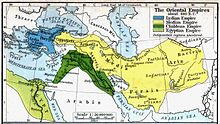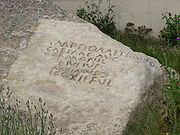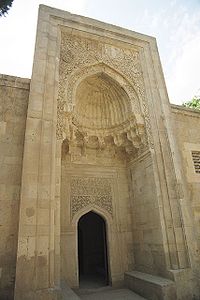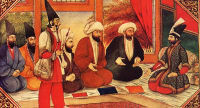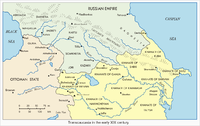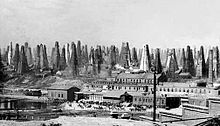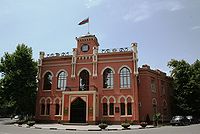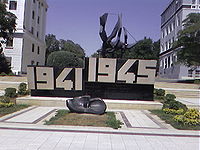- History of Azerbaijan
-
This article is about the history of Azerbaijan. For the history of Iranian Azerbaijan, see history of Iran.
History of Azerbaijan 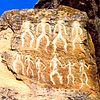
This article is part of a seriesAntiquity Ancient history and Roman era Atropatene First Persian Empire
and Alexander's conquestsCaucasian Albania Middle Ages Islamic period Seljuk dynasty Atabegs of Azerbaijan Ilkhanate Qara Qoyunlu Aq Qoyunlu Shirvanshahs Classical history Safavid dynasty Khanates Qajar dynasty Russian Rule Early independence History of the name Azerbaijan Azerbaijan Democratic Republic March Days Soviet Azerbaijan Azerbaijan SSR Black January Modern Azerbaijan Republic of Azerbaijan
Azerbaijan Portal
Azerbaijan or Azarbaijan (Azerbaijani: آذربایجان Azərbaycan) is a country in the Caucasus region of Eurasia. It's bounded by Caspian Sea to the east, Russia's Daghestan region to the north, Georgia to the northwest, Armenia and Turkey to the southwest, and Iran to the south. Azerbaijan is a home to various ethnicities, majority of which are Turks, an ethnic group which numbers close to 9 million in the independent Republic of Azerbaijan.
During Median and Persian rule, many Caucasian Albanians adopted Zoroastrianism and then switched to Christianity prior to coming of Muslim Arabs and more importantly Muslim Turks. The Turkic tribes are believed to have arrived as small bands of ghazis whose conquests led to the Turkification of the population as largely native Caucasian and Iranian tribes adopted the Turkic language of the Oghuz and converted to Islam over a period of several hundred years.[1]
After more than 80 years of colonization under the Russian empire in the Caucasus, the Azerbaijan Democratic Republic was established in 1918. The state was invaded by Soviet forces in 1920 and remained under Soviet rule until the collapse of the Soviet Union in 1991.
Contents
Prehistory
Paleolithic
The cave of Azykh in the territory of the Fizuli district in the Republic of Azerbaijan is considered to be the site of one of the most ancient proto-human habitations in Eurasia. Remnants of the pre-Acheulean culture were found in the lowest layers of the Azykh cave. This culture is one of the oldest, and in many ways similar to the Olduvai culture in Tanzania, and Walloon culture in the southeast of France.
The Paleolithic (Homo Sapiens) period in what is now Azerbaijan is represented by finds at Aveidag, Taglar, Damjily, Yatagery, Dash Salakhly and some other sites. Carved drawings etched on rocks in Qobustan, south of Baku, demonstrate scenes of hunting, fishing, labor and dancing, and are dated to the Mesolithic period.
Neolithic
The Neolithic period (ca. 6th – 4th millennia BC) was the period of transition from the Stone Age to the Bronze Age. Many Neolithic settlements have been discovered in Azerbaijan, and carbon-dated artifacts show that during this period, people built homes, made copper weapons, and were familiar with irrigated agriculture.
Bronze to Iron Ages
The influence of ancient peoples and civilizations including the Sumerians and Elamites came to a crossroads in the territory of Azerbaijan. A variety of Caucasian peoples appear to be the earliest inhabitants of the South Caucasus with the notable Caucasian Albanians being their most prominently known representative.
In the 8th century BC, the semi-nomadic Cimmerians and Scythians settled in the territory of kingdom of Mannai. The Assyrians also had a civilization that flourished to the west of Lake Urmia in the centuries prior to creation of Media and Albania. Most of the ancient documents and inscriptions used for historical analysis of the area come from the Assyrians and from the kingdom of Urartu. In dealing with the history of Azerbaijan, most western scholars refer to Greek, Arab, Roman, and Persian sources.
Caucasian Albanians are believed to be the earliest inhabitants of Azerbaijan.[2] Early invaders included the Scythians in the 9th century BCE.[3] The South Caucasus was eventually conquered by the Achaemenids around 550 BCE. During this period, Zoroastrianism spread in Azerbaijan. The Achaemenids in turn were defeated by Alexander the Great in 330 BCE. Following the decline of the Seleucids in Persia in 247 BCE, an Armenian Kingdom exercised control over parts of modern Azerbaijan between 190 BCE to 428 CE.[4][5] Caucasian Albanians established a kingdom in the 1st century BCE and largely remained independent until the Sassanids made the kingdom a province in 252 CE.[2][6][7] Caucasian Albania's ruler, King Urnayr, officially adopted Christianity as the state religion in the 4th century CE, and Albania would remain a Christian state until the 8th century.[8][9] Sassanid control ended with their defeat by Muslim Arabs in 642 CE.[10]
The successive migration and settlement of Eurasian and Central Asian nomads continued to be a familiar pattern in the history of the Caucasus since ancient times, from the era of Sassanid-Persian empire to emergence of Azerbaijani Turks by the 20th century CE. Among the Iranian nomads who made incursion into and from Azerbaijan are the Scythians, Alans and Cimmerians. Altaic Nomads such as Khazars and Huns made incursions during the Hunnic and Khazar era. The walls and fortification of Darband were built during the Sassanid era in order to block nomads coming from the caucus pass. However, they did not make permanent settlements.[11]
Antiquity
Achaemenid and Seleucid rule
Following the overthrow of the Median Empire, all of what is today Azerbaijan was invaded by the Persian king Cyrus the Great in the 6th century BCE. This earliest Persian Empire had a profound impact upon local population as the religion of Zoroastrianism became ascendant as did various early Persian cultural influences. Many of the local peoples of Caucasian Albania came to be known as fire worshipers, which may be a sign of their Zoroastrian faith.
This empire was also quite short-lived and was conquered barely two centuries later by Alexander the Great and led to the rise of Hellenistic culture throughout the former Persian Empire. The Seleucid Greeks inherited the Caucasus following Alexander's death in 323 BCE, but were ultimately beset by pressures from Rome, secessionist Greeks in Bactria, and most adversely the Parthians (Parni), another nomadic Iranian tribe from Central Asia, which made serious inroads into the northern eastern Seleucid domains from the late 4th century BCE to the 3rd century BCE and this ultimately allowed local Caucasian tribes to establish an independent kingdom for the first time since the Median invasion.
Caucasian Albania, Roman-Parthian rivalry, and Sassanian conquest
The Albanian kingdom coalesced around a native Caucasian identity to forge a unique state in a region of vast empire-states. However in the 2nd or 1st century B.C. the Armenians considerably curtailed the Albanian territories to the south and conquered the territories of Artsakh and Utik, populated by various Albanian tribes, such as Utians, Gargarians and Caspians.[12][13] During this time the border between Albania and Armenia was along the river of Kura.[14][15]
As the region became an arena of wars when Romans and Parthians began to expand their domains, most of Albania came under the domination of Roman legions under Pompey and the south being controlled by the Parthians. A rock carving of what is believed to be the eastern-most Roman inscription survives just southwest of Baku at the site of Gobustan. It is inscribed by Legio XII Fulminata at the time of emperor Domitian.
After the division of Armenia between Byzantium and Persia in 387 A.D. the Albanian kings regained control over the provinces of Uti and Artsakh (lying south of the Kur), when Sasanian kings rewarded Albanian Arsacid rulers for their royalty to Persia.[13][16]
Medieval historians, such as Movses Khorenatsi and Movses Kaghankatvatsi, write that Albanians converted to Christianity in the 4th century A.D. by the efforts of Gregory the Illuminator of Armenia.[17][18] However Christianity spread in Albania only gradually, and a large part of Albanians remained Zoroastrians and pagans until the Islamic conquest.
Middle Ages
Islamic conquest
Main article: Muslim conquest of the Sassanid EmpireMuslim Arabs defeated the Sassanids and Byzantines as they marched into the Caucasus region. The Arabs made Caucasian Albania a vassal state after the Christian resistance, led by Prince Javanshir, surrendered in 667.[2] Between the 9th and 10th centuries, Arab authors began to refer to the region between the Kura and Aras rivers as Arran.[2] During this time, Arabs from Basra and Kufa came to Azerbaijan and seized lands that the indigenous peoples had abandoned.
Seljuqs and successor states
The Seljuq period of Azerbaijan's history was possibly even more pivotal than the Arab conquest as it helped shape the ethno-linguistic nationality of the modern Azerbaijani Turks.
After decline of Abbasid Khalifate, the territory of Azerbaijan was under the sway of numerous dynasties such as the Salarids, Sajids, Shaddadids, Rawadids and Buyids. However at the beginning of the 11th century, the territory was gradually seized by waves of Oghuz Turkic tribes emanating from Central Asia. The first of these Turkic dynasties was the Ghaznavids from northern Afghanistan, who took over part of Azerbaijan by 1030. They were followed by the Seljuqs, a western branch of the Oghuz who conquered all of Iran and the Caucasus and pressed on to Iraq where they overthrew the Buyids in Baghdad in 1055.
The Seljuqs became the main rulers of a vast empire that included all of Iran, Iraq, and Azerbaijan until the end of 12th century. During the Seljuq period, the influential vizier of the Seljuq sultans, Nizam ul-Mulk (a noted Persian scholar and administrator) is noted for having helped introduce numerous educational and bureaucratic reforms. His death in 1092 marked the beginning of the decline of the once well-organized Seljuq state that further deteriorated following the death of Sultan Ahmad Sanjar in 1153.
Locally, Seljuq possessions were ruled by Atabegs, who were technically vassals of the Seljuq sultans, but sometimes became de facto rulers themselves. The title of Atabeg was common during the Seljuq rule of the Middle East starting in the 12th century. Under their rule from the end of 12th to early 13th centuries, Azerbaijan emerged as an important cultural center of the Turkic people. Palaces of the Atabeg Eldegizids (eldeniz) and the Shirvanshahs hosted distinguished people of the time, many of whom were outstanding Muslim artisans and scientists. The most famous of the Atabeg rulers was Shams al-din Eldeqiz (Eldeniz).
Under Seljuqs, great progress was achieved in different sciences and philosophy by Iranians like Bahmanyar, Khatib Tabrizi, Shahab al-Din Suhrawardi and others. Persian poets such as Nizami Ganjavi and Khaqani Shirvani, who lived in this region, epitomize the highest point in refined medieval Persian literature. In addition, the region experience a building boom and the unique of architecture of the Seljuq period is epitomized by the fortress walls, mosques, schools, mausoleums, and bridges of Baku, Ganja and Absheron which were built during the 12th century.
In 1225, Jalaleddin Kharazmshah of Khwarezmid Empire put an end to the Atabeg rule.
Mongols and Ilkhanid rule
The Mongol invasion of the Middle East and Caucasus was a devastating event for Azerbaijan and most of its neighbors. From 1220, Begin beg began to pay tributes to the Mongols. Jebe and Subotai made the small state neutral. In 1231, the Mongols occupied most of Azerbaijan and killed the Khorezmshah Jalaladdin, who had overthrown the Atabeg dynasty. In 1235 the Mongols destroyed cities of Ganja, Shamkir, Tovuz, Shabran on their way to conquer Kievan Russia. By the 1236, all of Transcaucasia was in the hands of Ogedei khan.
The end of Mongol rule and the Black Sheep-White Sheep rivalry
The last Il-khanid ruler, Abu Sa'id, died without an heir which led to the Ilkhan state's disintegration into small sultanates. The next state in the territory of Azerbaijan, in the 1330s, was that of the Jalayirids, who ruled Iraq, western Persia, and most of Azerbaijan. The Jalayirid Sultanate lasted about fifty years, until it was disrupted by Tamerlane's conquests and the revolts of the Kara Koyunlu (Qara Qoyunlu) also known as 'Black Sheep Turks'.
The first Jalayirid ruler was Hasan Buzurg (d. 1356) who ascended the throne in Tabriz in 1337. His son Shaikh Uvais defeated his most serious potential rivals, the Chobanids (descendants of Amir Coban (Chobanids)) to consolidate his rule. He reigned over Azerbaijan from 1360 to 1374 during a period of peace and stability. After the rule of the weak Sultan Husain, the Jalayirid state declined.
Tamerlane (Amir Timur) launched a devastating invasion of Azerbaijan in 1380s, and temporarily incorporated Azerbaijan into his vast domain that spanned much of Eurasia. The Shirvanshah state under Shirvanshah Ibrahim I were also vassals of Timur and assisted Timur in his war with the Mongol ruler Tokhtamysh of the Golden Horde. Azerbaijan experienced social unrest and religious strife during this period due to sectarian conflict initiated by Hurufi, Bektashi and other movements.
Following Timur's death in 1405, his fourth son Shah-Rukh came to power and reigned until 1446. To the west of Shah-Rukh's domain two new rival Turkic states emerged – the Kara Koyunlu based around Lake Van and the Ak Koyunlu (or White Sheep Turks) centered around Diyarbakır. Initially, it was the Kara Koyunlu who were ascendant when their chief Kara Yusuf overcame Sultan Ahmad, the last of Jalayirids, and conquered South of Azerbaijan in 1410, establishing his capital at Tabriz. Under Jahan-Shah, the Kara Koyunlu expanded their territory into central Iran and as far east as Khurasan. Later, however, the Ak Koyunlu came into greater prominence under Uzun Hasan, overcoming Jahan-Shah and the Qara Qoyunlu in 1468. Uzun Hasan ruled all of Iran, Azerbaijan and Iraq until his death in 1478. Both Ak Koyunlu and Kara Koyunlu, continued the Timurid tradition of generous patrons of literature, poetry and the arts as the renowned Islamic miniature paintings of Tabriz illustrate.
The Shirvanshahs
Main article: ShirvanshahsShīrwān Shāh[19] or Sharwān Shāh,[19] was the title in mediaeval Islamic times of a Persianized dynasty[19] of Arabic origin.[19] The Shirvanshah established a native Azeri state[20] and were rulers of Shirvan, a historical region in present-day Azerbaijan. The Shirvanshahs established the longest Islamic dynasty in the Islamic world.
The role of the Shirvanshah state was important in the national development of Azerbaijan. The Shirvanshahs maintained a high degree of autonomy as local rulers and vassals from 861 until 1539, and provided a continuity that lasted longer than any other dynasty in the Islamic world. There are two periods of an independent Shirvan state: first in 12th century, under sultans Manuchehr and Axsitan who built the stronghold of Baku, and second in 15th century under the Derbendid dynasty. Between the 13th and 14th centuries, the Shirvanshahs were vassals of the Mongol and Timurid empires.
The Shirvanshahs Khalilullah I and Farrukh Yassar presided over a highly stable period in the history of the dynasty. The architectural complex of the "Shirvanshah palace" in Baku (that was also a burial site of the dynasty) and the Halwatiyya Sufi Khaneqa were built during the reign of these two rulers in the mid-15th century. The Shirvanshah rulers were more or less Orthodox Sunni, and thus opposed the heterodox Shi'a Islam of the Safavid Sufi order. In 1462 Shaykh Junayd, the leader of Safavids was killed in battle against Shirvanishans, near town of Gusar (he was buried in the village Hazra) – an event that shaped subsequent Safavid actions leading to a new phase in the history of Azerbaijan.
Safavids and the rise of Shi'a Islam
Main article: SafavidsThe Safavid (Safaviyeh) were a Sufi religious order formed in 1330s by Sheikh Safi Al-Din (1252–1334), after whom it was eponymously named.
This Sufi order openly converted to the heterodox branch of twelver Shi'a Islam by the end of the 15th century. Some Safavid followers, most notably the Qizilbash Turks, believed in the mystical and esoteric nature of their rulers and their relationship to the house of Ali, and thus, were zealously predisposed to fight for them. The Safavid rulers claimed to be descended from Ali himself and his wife Fatimah, daughter of the Prophet Muhammad, through the seventh Imam Musa al-Kazim. Qizilbash numbers increased by the 16th century and their generals were able to wage a successful war against the Ak Koyunlu state and capture Tabriz.
The Safavids, led by Ismail I, expanded their base, sacking Baku in 1501 and persecuting the Shirvanshahs.
During the reign of Ismail I and his son Tahmasp, Shi'a Islam was imposed upon the formerly Sunni population of Iran and Azerbaijan. Imposition of Shi'a Islam was especially harsh in Shirvan, where a large Sunni population was massacred. Iran became a feudal theocracy during this period and the Shah was held to be the divinely ordained head of state and religion. During this period, the Qizilbashi chiefs were designated wakils (or legal administrators) with offices in charge of provincial administration and the class of Shia Islamic Ulema was created.
The wars with the Sunni Ottoman Empire continued during the reign of Shah Tahmasp. The important Azeri cities of Shamakha, Ganja and Baku were occupied by Ottomans in the 1580s.
Under the reign of Shah Abbas I (1587–1630) the monarchy took on a distinctly Persian national identity that merged with Shi'a Islam. Abbas I's reign represented the high point of development of the state and he was able to repel the Ottomans and re-capture Azerbaijan and Shirvan in 1603.
Khanates of late 18th – early 19th centuries
While civil conflicts took hold in Iran, most of Azerbaijan was occupied by the Ottomans in the 18th century. Meanwhile, the coastal strip along the Caspian Sea comprising Derbent, Baku and Salyan came under Imperial Russian rule, during the reign of Peter the Great, from 1722 until 1735.
After the collapse of the Safavid empire, Nadir Shah Afshar (Nadir Guli Bey), a former slave who had risen to military leadership within the Afshar Turkoman tribe in Khorasan (a vassal state of the Safavids) came to power. He wrested control over Iran from the Afghans in 1729 and proceeded to go on an ambitious military spree, conquering as far as east as Delhi, but not fortifying his Persian base and exhausted his army. Nadir had effective control over Shah Tahmasp II and then ruled as the Regent of the infant Abbas III, until 1736, when he had himself crowned as Shah. The coronation of Nadir Shah took place in Mughan, in the present territory of Azerbaijan, where the Azeri military and tribal aristocracy gathered.
After Nadir Shah's assassination in 1747, Iran disintegrated. Several Muslim Iranian khanates[21] [22] that were sometimes de facto independent[23][24][25][26] founded under nominal Persian suzerainty[27] [25][28][29] . Within Azerbaijan, emerged the khanates of Shirvan, Baku, Karabakh, Ganja, Quba, Shaki, Talysh, Erivan, Nakhchivan and other small city-states. The khanates engaged in constant warfare between themselves and with external threats. The most powerful among the northern khans was Fat'h Ali Khan of Quba (died 1783), who managed to unite most of the neighboring khanates under his rule and even mounted an expedition to take Tabriz, fighting with Zand dynasty. Another powerful khanate was that of Karabakh, which subdued neighboring Nakhchivan khanate and parts of Erivan khanate.
By 1796, Agha Muhammed Khan Qajar raided and conquered Azerbaijan and Georgia. Some khanates made the fateful decision to ask for Russian help, while other Azeris were content with Qajar rule. However, the Russians, who by this time controlled Georgia, had already subjugated most of the khanates in the Caucasus by 1806. The Qajars responded to these events by declaring war, which continued until 1813 when Russians invaded Tabriz.
According to Prof. Tadeusz Swietochowski:
“ "The brief and successful Russian campaign of 1812 was concluded with the Treaty of Gulistan, which was signed on October 12 of the following year. The treaty provided for the incorporation into the Russian Empire of vast tracts of Iranian territory, including Daghestan, Georgia with the Sheragel province, Imeretia, Guria, Mingrelia, and Abkhazia, as well as the khanates of Karabagh, Ganja, Sheki, Shirvan, Derbent, Kuba, Baku, and Talysh. ” According to Svante Cornell:
“ In 1812 Russia ended a war with Turkey and went on the offensive against Iran. This led to the treaty of Gulistan in 1813, which gave Russia control over large territories that hitherto had been at least nominally Iranian, and moreover a say in Iranian succession politics. The whole of Daghestan and Georgia, including Mingrelia and Abkhazia were formally ceded to Russia, as well as eight Azeri Khanates (Karabakh, Ganja, Sheki, Kuba, Shirvan, Talysh, Baku, and Derbent). However as we have seen the Persians soon challenged Russia 's rule in the area, resulting in a military disaster. Iran lost control over the whole of Azerbaijan, and with the Turkemenchai settlement of 1828 Russia threatened to establish its control over Azerbaijan unless Iran paid a war indemnity. The British helped the Iranians with the matter, but the fact remained that Russian troops had marched as far as south of Tabriz. Although certain areas (including Tabriz) were returned to Iran, Russia was in fact at the peak of its territorial expansion.[26] ” According to the Cambridge History of Iran:
“ Even when rulers on the plateau lacked the means to effect suzerainty beyond the Aras, the neighboring Khanates were still regarded as Iranian dependencies. Naturally, it was those Khanates located closest to the province of Āzarbāījān which most frequently experienced attempts to re-impose Iranian suzerainty: the Khanates of Erivan, Nakhchivān and Qarābāgh across the Aras, and the cis-Aras Khanate of Ṭālish, with its administrative headquarters located at Lankarān and therefore very vulnerable to pressure, either from the direction of Tabrīz or Rasht. Beyond the Khanate of Qarābāgh, the Khān of Ganja and the Vāli of Gurjistān (ruler of the Kartli-Kakheti kingdom of south-east Georgia), although less accessible for purposes of coercion, were also regarded as the Shah's vassals, as were the Khāns of Shakki and Shīrvān, north of the Kura river. The contacts between Iran and the Khanates of Bākū and Qubba, however, were more tenuous and consisted mainly of maritime commercial links with Anzalī and Rasht. The effectiveness of these somewhat haphazard assertions of suzerainty depended on the ability of a particular Shah to make his will felt, and the determination of the local khans to evade obligations they regarded as onerous.[31]
” Russian rule
Following their defeat by Russia, Qajar Persia was forced to sign the Treaty of Gulistan in 1813, which acknowledged the loss of the territory to Russia. Local khanates were either abolished (like in Baku or Ganja) or accepted Russian patronage. Another Russo-Persian war in 1826–28 resulted in another crushing defeat for the Iranian army. The Russians dictated another final settlement as per the Treaty of Turkmenchay, which resulted in the Qajars of Persia ceding Caucasian territories in 1828. The treaty established the current borders of Azerbaijan and Iran as the rule of local khans ended. In the Russian controlled territories, two provinces were established that later constituted the bulk of the modern Republic – Elisavetpol (Ganja) province in the west, and Shamakha province in the east.
At the beginning of Russian administration, the Tsars did not significantly interfere with local affairs and the migration of the Christian population into Azerbaijan was minimal. As a result of a catastrophic earthquake in 1858, the capital of the eastern province was transferred from Shamakha to Baku which attained greater importance over time.
The discovery and exploitation of petroleum in the 1870s led to a period of unprecedented prosperity and growth in the years prior to World War I but also created huge disparities in wealth between the largely European capitalists and the local Muslim work force. By 1900, the population of Baku increased from 10,000 to roughly 250,000 people as a result of worker migration from all over the Russian Empire, Iran, and other places. The growth of Baku and the progression of an exploitative economy resulted in the emergence of an Azeri nationalist intelligencia that was educated and influenced by European and Ottoman ideas. Influential thinkers like Hasan bey Zardabi, Mirza Fatali Akhundov and later, Jalil Mammadguluzadeh, Mirza Alakbar Sabir, Nariman Narimanov and others spurred a nationalist discourse and rallied against poverty, ignorance, extremism and sought reforms in education and the emancipation of the dispossessed classes, including women. The financial support of philanthropist millionaires such as Haji Zeynalabdin Taghiyev also bolstered the rise of an Azeri middle-class.
Following the disastrous Russo-Japanese war, an economic and political crisis erupted in Baku, starting with a general strike of oil workers in 1904. In 1905, class and ethnic tensions resulted in Muslim-Armenian ethnic rioting during the first Russian Revolution. The Tsarist governments had, in fact, exploited ethnic and religious strife to maintain control in a policy of divide and rule.
The situation improved during 1906–1914, when a limited parliamentary system was introduced in Russia and Muslim MPs from Azerbaijan were actively promoting Azeri interests. In 1911, the pan Turkist and pan Islamist Musavat Party,[32][33][34][35][36][37] inspired by the left of center modernizing ideology espoused by Mammed Amin Rasulzade, was formed. Founded clandestinely, the party expanded rapidly in 1917, after the overthrow of the Tsarist regime in Russia. The most essential components of the Musavat ideology were secularism, nationalism, and federalism, or autonomy within a broader political structure. However, the party's right- and left-wings differed on certain issues, most notably land distribution. The leader of the party was the left-leaning Mammed Amin Rasulzade.
After Russia became involved in World War I, social and economic tensions spiked again. The Russian Revolution of 1917 ultimately led to the granting of rights to the local population of Azerbaijan and the granting of self rule, but this autonomy also led to renewed ethnic conflict between Azeris and Armenians.
Azerbaijan Democratic Republic
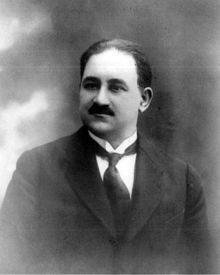 Mammed Amin Rasulzade was one of the founding leaders and speaker of Azerbaijan Democratic Republic in 1918, widely regarded as the national leader of Azerbaijan.
Mammed Amin Rasulzade was one of the founding leaders and speaker of Azerbaijan Democratic Republic in 1918, widely regarded as the national leader of Azerbaijan. Main articles: Azerbaijan Democratic Republic, Armenian-Azerbaijani war (1918 - 1920), March Days, and Battle of Baku
Main articles: Azerbaijan Democratic Republic, Armenian-Azerbaijani war (1918 - 1920), March Days, and Battle of BakuAt the collapse of the Russian Empire in 1917, an independent republic was proclaimed in Ganja on May 28, 1918 following an abortive attempt to establish a federal Transcaucasian Republic with Armenia and Georgia. This was the first Democratic Republic established in Islamic World. In Baku, however, a coalition of Bolsheviks, Dashnaks and Mensheviks fought against a Turkish-Islamic army led by Nuru Pasha. This coalition known as the "Baku Commune" also inspired or tacitly condoned the massacres of local Muslims by well-armed Dashnak-Armenian forces. This coalition, however, collapsed and was replaced by a British-controlled government known as Central Caspian Dictatorship in July, 1918. British forces under General Dunsterville occupied Baku and helped the mainly Dashnak-Armenian forces to defend the capital. However, Baku fell on September 15, 1918 and an Azeri-Ottoman army entered the capital, causing British forces and much of the Armenian population to flee. The Ottoman Empire, however, capitulated on October 30, 1918 and the British occupational force re-entered Baku.
Azerbaijan was proclaimed a secular republic and its first parliament opened on December 5, 1918. British administration initially did not recognize the Republic but tacitly cooperated with it. By mid-1919 the situation in Azerbaijan had more or less stabilized, and British forces left in August, 1919. However by early 1920, advancing Bolshevik forces, victorious in Russian Civil War, started to pose a great threat to young republic, which also engaged in a conflict with Armenia over the Karabakh.
Azerbaijan received de facto recognition by the Allies as an independent nation in January 1920 at the Versailles Paris Peace Conference. The republic was governed by five cabinets, all formed by a coalition of the Musavat and other parties including the Socialist Bloc, the Independents, the Liberals, the Social-Democratic Party Hummat (or Endeavor) Party and the Conservative Ittihad (Union) Party. The premier in the first three cabinets was Fatali Khan Khoyski; in the last two, Nasib Yusifbeyli. The president of the parliament, Alimardan Topchubashev, was recognized as the head of state. In this capacity he represented Azerbaijan at the Versailles Paris Peace Conference in 1919.
Aided by Azeri dissidents in the Republican government, the Red Army invaded Azerbaijan on April 28, 1920. The bulk of the newly formed Azerbaijani army was engaged in putting down an Armenian revolt that had just broken out in Karabakh. The Azeris did not surrender their brief independence of 1918–20 quickly or easily. As many as 20,000 died resisting what was effectively a Russian reconquest.[38] However, it has to be noticed that the installation of the Azerbaijan Soviet Socialist Republic was made easier by the fact that there was a certain popular support for Bolshevik ideology in Azerbaijan, in particular among the industrial workers in Baku.[39] The same day a Soviet government was formed under Nariman Narimanov. Before the year was over, the same fate had befallen Armenia, and, in March 1921, Georgia as well.
Soviet Azerbaijan
Main articles: Azerbaijan SSR and Azerbaijan during World War IIAfter the peaceful surrender of the national government to Bolshevik forces, Azerbaijan was proclaimed a Soviet Socialist Republic on April 28, 1920. Shortly after the Congress of the Peoples of the East was held in September 1920 in Baku. Although, formally an independent state, the Azerbaijan SSR was dependent upon and controlled by the government in Moscow. It was incorporated into the Transcaucasian SFSR along with Armenia and Georgia in March 1922. By an agreement signed in December 1922, the TSFSR became one of the four original republics of the Soviet Union. The TSFSR was dissolved in 1936 and its three regions became separate republics within the USSR.
Like other union republics, Azerbaijan, was affected by Stalin's purges in the 1930s. During this period, sometimes referred to as the "Red Terror", thousands of people were killed, including notable Azeri figures such as Huseyn Javid, Mikail Mushvig, Ruhulla Akhundov, Ayna Sultanova and others. Directing the purges in Azerbaijan was Mir Jafar Baghirov, the first secretary of the Communist Party of Azerbaijan, who followed Stalin's orders without question. His special target was the intelligentsia, but he also purged Communist leaders who had sympathized with the opposition or who might have once leaned toward Pan-Turkism or had contacts with revolutionary movements in Iran or Turkey.
During the 1940s, the Azerbaijan SSR supplied much of the Soviet Union's gas and oil during the war with Nazi Germany and was thus a strategically important region. The German invasion of the Soviet Union in June 1941 reached the Greater Caucasus in July 1942, but the Germans never crossed into the territory of Azerbaijan. Many Azerbaijanis fought well in the ranks of the Soviet Army (about 600–800,000) and Azeri Major-General Azi Aslanov was awarded twice Hero of the Soviet Union. About 400,000 Azeris died in World War II. The Germans also made fruitless efforts to enlist the cooperation of emigre political figures, most notably Mammed Amin Rasulzade.[citation needed]
See also: Azerbaijan SSR during the Soviet-German WarPolicies of de-Stalinization and improvement after the 1950s led to better education and welfare conditions for most of Azerbaijan. This also coincided with the period of rapid urbanization and industrialization. During this period of change, a new anti-Islamic drive and return to a policy of Russification, under the policy of sblizheniye (reapprochment), was instituted in order to merge all the peoples of the U.S.S.R. into a new monolithic Soviet nation.
In the 1960s, the signs of a structural crisis in the Soviet colonial system began to emerge. Azerbaijan's crucial oil industry lost its relative importance in the Soviet economy, partly because of a shift of oil production to other regions of the Soviet Union and partly because of the depletion of known oil resources on land, while offshore production was not deemed cost effective. As a result, Azerbaijan had the lowest rate of growth in productivity and economic output among the Soviet republics, with the exception of Tajikistan. Ethnic tensions, particularly between Armenians and Azerbaijanis began to grow, but violence was suppressed.
In an attempt to end the growing structural crisis, in 1969, the government in Moscow appointed Heydar Aliyev as the first secretary of the Communist Party of Azerbaijan. Aliyev temporarily improved economic conditions and promoted alternative industries to the declining oil industry, such as cotton. He also consolidated the republic's ruling elite, which now consisted almost entirely of ethnic Azeris, thus reverting the previous trends at "reapprochment". In 1982 Aliyev was made a member of the Communist Party's Politburo in Moscow, the highest position ever attained by a Muslim in the former Soviet Union. In 1987, when Perestroika started, he was forced to retire by the Soviet leader Mikhail Gorbachev whose policies Aliyev opposed.
The late 1980s, during the Gorbachev era, were characterized by increasing unrest in the Caucasus, initially over the Nagorno-Karabakh issue. A political awakening came in February 1988 with the renewal of the ethnic conflict, which centered on Armenian demands for the unification of Nagorno-Karabakh Autonomous Oblast of Azerbaijan SSR with Armenian SSR. Armenians expelled hundreds of thousands of Azeris from Karabakh and Armenia by March 1988, while pogroms of the Armenian population in Baku and Sumgait took place. Russia forced enforced military rule on several occasions but unrest continued to spread.
The ethnic strife revealed the shortcomings of the Communist Party as a champion of national interests, and, in the spirit of glasnost, independent publications and political organizations began to emerge. Of these organizations, by far the most prominent was the Popular Front of Azerbaijan (PFA), which by the fall of 1989 seemed poised to take power from the Communist Party. The PFA soon experienced a split between a conservative-Islamic wing and a moderate wing. The split was followed by an outbreak of anti-Armenian violence in Baku and intervention by Soviet troops.
Unrest culminated in violent confrontation when Soviet troops killed 132 nationalist demonstrators in Baku on January 20, 1990. Azerbaijan declared its independence from the USSR on August 30, 1991, and became part of the Commonwealth of Independent States. By the end of 1991 fighting in Nagorno-Karabakh had escalated into a full scale war, which culminated into a tense cease-fire that has persisted into the 21st century. Although a cease-fire was achieved, the refusal to negotiate by both sides resulted in a stalemate as Armenian troops retained their positions in Karabakh as well as corridors taken from Azerbaijan that connect the enclave to Armenia.
Independent Azerbaijan
Mutalibov presidency (1991-1992)
While during 1990–1991 Azerbaijan gave more sacrifices in a struggle for independence from the USSR than any other Soviet republic[citation needed], the declaration of independence introduced by President Ayaz Mutalibov on August 30, 1991 followed the 1991 Soviet coup d'état attempt. Mütallibov becomes the only Soviet leader besides Zviad Gamsakhurdia to endorse the Soviet coup attempt by issuing a statement from Tehran, while later dissolving the Communist Party of Azerbaijan and proposing constitutional changes for direct nationwide elections of president.
On September 8, 1991, the first nation-wide presidential elections, in which Mutalibov was the only running candidate, were held in Azerbaijan. While the elections were neither free nor fair by international standards, Mutalibov formally became the elected president of Azerbaijan. The adoption of the Declaration of Independence by the Supreme Soviet of Azerbaijan SSR on October 18, 1991 was followed by a dissolution of the Azerbaijani Communist Party. However, its former members, including President Ayaz Mutalibov, retained their political posts.
In December, 1991 in a nationwide referendum, Azerbaijani voters approved the Declaration of Independence adopted by the Supreme Council; with the dissolution of the Soviet Union, Azerbaijan is recognized as independent state at first by Turkey, Israel, Romania and Pakistan.
Meanwhile, the conflict over Nagorno Karabakh continued despite the efforts to negotiate a settlement. Early in 1992, Karabakh's Armenian leadership proclaimed an independent republic. In what was now a full scale war between Armenia and Azerbaijan, the Armenians gained the upper hand, with covert assistance from the Russian Army. Major atrocities were committed by both sides, with the Khojaly massacre of Azeri civilians on February 25, 1992 causing a social uproar over the government inaction. Mütallibov was forced to submit his resignation to the National Assembly of Azerbaijan on March 6, under pressure from the Azerbaijan Popular Front.
Mutalibov's failure to build up an adequate army, that he feared may not remain under his control, brought about the downfall of his government. On May 6 the last Azerbaijani-populated town in Nagorno-Karabakh, Shusha, falls under Armenian control. On May 14 the Supreme Council of Azerbaijan hears the case on the Khojaly Massacre, relieves Mütallibov of any responsibility, reverses his prior resignation and restores him as the President of Azerbaijan, but the day after, May 15, armed forces led by the Azerbaijan Popular Front take control of the offices of the Parliament of Azerbaijan and Azerbaijani State Radio and Television, thereby deposing Mütallibov, who leaves for Moscow; the Supreme Council of Azerbaijan is dissolved passing the duties to the National Assembly of Azerbaijan formed by equal representation of Azerbaijan Popular Front and former communists. Two days later, while Armenian forces take control of Lachin, Isa Gambar is elected as the new Chairman of the National Assembly of Azerbaijan and takes on the temporary duties of President of Azerbaijan until the national elections due on June 17, 1992.
Elchibey presidency (1992-1993)
The former Communists failed to present a viable candidate at the 1992 elections and Abulfaz Elchibey, the leader of the Popular Front of Azerbaijan(PFA) and former dissident and political prisoner, was elected president with more than 60% of the vote. His program included opposition to Azerbaijan's membership in the Commonwealth of Independent States, closer relations with Turkey, and a desire for extended links with the Iranian Azerbaijanis.
Heydar Aliyev, who had been prevented from running for president by an age limit of 65, was doing well in Nakhichevan. He had to contend with an Armenian blockade of Nakhichevan. In turn, Armenia suffered when Azerbaijan halted all rail traffic into and out of Armenia, cutting most of its land links with the outside world. The negative economic effects of the Armenian-Azerbaijani conflict seemed to illustrate the interdependence of the Transcaucasian nations.
Within a year after his election, President Elchibey came to face the same situation that had led to the downfall of Mutalibov. The fighting in and around Nagorno Karabakh steadily turned in favor of the Armenians, who seized around one fifth of Azerbaijan's territory, creating more than a million internally displaced persons. A military rebellion against Abulfaz Elchibey broke out in early June 1993 in Ganja under the leadership of Colonel Surat Huseynov. The Popular Front of Azerbaijan leadership found itself without political support as a result of the war's setbacks, a steadily deteriorating economy, and opposition from groups led by Heydar Aliyev. In Baku, Aliyev seized the reins of power and quickly consolidated his position. A confidence referendum in August deprived Elchibey of his post.
Heydar Aliyev presidency (1993-2003)
On 3 October 1993 a presidential election was held, and Aliyev won overwhelmingly. By March 1994, Aliyev was able to get rid of some of his opposition including Surat Huseynov, who was arrested along with other rivals. In 1995, the former military police were accused of plotting a coup and disbanded. Coup plotters were linked to right wing Turkish nationalists. Later, in 1996 Rəsul Quliyev, former speaker of parliament went into self-imposed exile. Thus, by end of 1996, position of Heydar Aliyev as an absolute ruler in Azerbaijan was unquestionable.
As a result of limited reforms and the signing of the so-called "Contract of The Century" in October 1994 (over the Azeri-Chirag-Guneshli giant oil field) that led to increased oil exports to western markets, the economy began improving. However, extreme levels of corruption and nepotism in the state system created by Aliyev prevented Azerbaijan from more sustained development, especially in the non-oil sector.
In October 1998, Aliev was re-elected as president for a second term. Weakened opposition accused him of voter fraud, but no widespread international condemnation of the elections followed. His second term in office was characterized by limited reforms, increasing oil production and the dominance of British Petroleum as a main foreign oil company in Azerbaijan. In early 1999, a giant Shah Deniz gas field was discovered making Azerbaijan potentially a major gas exporter. A gas export agreement was signed with Turkey by 2003. Work on a long awaited Baku-Tbilisi-Ceyhan oil pipeline and Baku-Tbilisi-Erzerum gas pipeline started in 2003. The oil pipeline was completed in 2005 and the gas pipeline in 2006. Azerbaijan is also a party to the proposed Nabucco Pipeline.
Heydar Aliyev fell ill and, in April 2003, collapsed on stage and could not return to public life. By summer 2003 he was placed into intensive care in the United States where he was pronounced dead on December 12, 2003.
Ilham Aliyev presidency (2003)
In yet another controversial election, his son Ilham Aliyev was elected president the same year. The election was characterized by mass violence and was criticised by foreign observers. Presently, political opposition to the Aliyev administration remained strong. Many were not satisfied with this new dynastical succession and were pushing for a more democratic government. Ilham Aliyev was re-elected in 2008 with 87% of the polls, while opposition parties boycotted the elections. In a constitutional referendum in 2009, term limits for the presidency were abolished and freedom of the press was restricted.
The 2010 parliamentary elections produced a Parliament completely loyal to Aliyev: for the first time in Azerbaijani history, not a single candidate from the main opposition Azerbaijan Popular Front or Musavat parties was elected. The Economist scored Azerbaijan as an authoritarian regime, at the 135° place on 167, in his 2010 Democracy Index.
Repeated protests were staged against Aliyev's rule in 2011, calling for democratic reforms and the ouster of the government. Aliyev has responded by ordering a security crackdown, using force to crush attempts at revolt in Baku, and refusing to make concessions. Well over 400 Azerbaijanis have been arrested since protests began in March 2011.[40] Opposition leaders, including Musavat's Isa Gambar, have vowed to continue demonstrating, although police have encountered little difficulty in stopping protests almost as soon as they begin.[41]
On 24 October 2011 Azerbaijan was elected as a non-permanent member to United Nations Security Council.[42][43] The term of office will begin on January 1, 2012.
Footnotes
- ^ Seyahatname by Evliya Çelebi (1611–1682)
- ^ a b c d Historical Dictionary
- ^ Azerbaijan – US Library of Congress Country Studies (retrieved 7 June 2006).
- ^ "Armenia-Ancient Period" – US Library of Congress Country Studies (retrieved 23 June 2006)
- ^ Strabo, "Geography" – Perseus Digital Library, Tufts University (retrieved 24 June 2006).
- ^ James Stuart Olson. An Ethnohistorical Dictionary of the Russian and Soviet Empires. ISBN 0313274975
- ^ Encyclopaedia Britannica: The list of provinces given in the inscription of Ka'be-ye Zardusht defines the extent of the empire under Shapur, in clockwise geographic enumeration: (1) Persis (Fars), (2) Parthia, (3) Susiana (Khuzestan), (4) Maishan (Mesene), (5) Asuristan (southern Mesopotamia), (6) Adiabene, (7) Arabistan (northern Mesopotamia), (8) Atropatene (Azerbaijan), (9) Armenia, (10) Iberia (Georgia), (11) Machelonia, (12) Albania (eastern Caucasus), (13) Balasagan up to the Caucasus Mountains and the Gate of Albania (also known as Gate of the Alans), (14) Patishkhwagar (all of the Elburz Mountains), (15) Media, (16) Hyrcania (Gorgan), (17) Margiana (Merv), (18) Aria, (19) Abarshahr, (20) Carmania (Kerman), (21) Sakastan (Sistan), (22) Turan, (23) Mokran (Makran), (24) Paratan (Paradene), (25) India (probably restricted to the Indus River delta area), (26) Kushanshahr, until as far as Peshawar and until Kashgar and (the borders of) Sogdiana and Tashkent, and (27), on the farther side of the sea, Mazun (Oman)
- ^ "Albania" – Encyclopaedia Iranica, vol. I, p. 807 (retrieved 15 June 2006).
- ^ "Voices of the Ancients: Heyerdahl Intrigued by Rare Caucasus Albanian Text" by Dr. Zaza Alexidze – Azerbaijan International, Summer 2002 (retrieved 7 June 2006).
- ^ "Islamic Conquest."
- ^ pp. 385–386
- ^ Hewsen, Robert H., Ethno-History and the Armenian Influence upon the Caucasian Albanians, in: Samuelian, Thomas J. (Hg.), Classical Armenian Culture. Influences and Creativity, Chico: 1982, 27–40.
- ^ a b Vladimir Minorsky. A History of Sharvān and Darband in the 10th–11th Centuries.
- ^ See: Strabo, Geography, 11.5 (English ed. H.C. Hamilton, Esq., W. Falconer, M.A.); also: Pliny the Elder, The Natural History, (eds. John Bostock, M.D., F.R.S., H.T. Riley, Esq., B.A.).
- ^ Hewsen, Robert H. Armenia: a Historical Atlas. Chicago, Illinois: University of Chicago Press, 2001
- ^ M. Chaumont, "Albania, Ancient country in Caucasus" Encyclopaedia Iranica
- ^ Moses Khorenatsi. History of the Armenians, translated from Old Armenian by Robert W. Thomson. Harvard University Press, 1978
- ^ Movses Kalankatuatsi. History of the Land of Aluank, translated from Old Armenian by Sh. V. Smbatian. Yerevan: Matenadaran (Institute of Ancient Manuscripts), 1984
- ^ a b c d Barthold, W., C.E. Bosworth "Shirwan Shah, Sharwan Shah". Encyclopaedia of Islam Edited by: P. Bearman, Th. Bianquis, C.E. Bosworth, E. van Donzel and W.P. Heinrichs. Brill, 2nd edition
- ^ Tadeusz Swietochowski. Russia and Azerbaijan: A Borderland in Transition, Columbia University, 1995, p. 2, ISBN 0231070683: "In the fifteenth century a native Azeri state of Shirvanshahs flourished north of the Araxes."
- ^ Multiple Authors. "AZERBAIJAN". Encyclopædia Iranica. http://www.iranicaonline.org/articles/azerbaijan-index. Retrieved 2011-October-09. "This new entity consisted of the former Iranian Khanates of Arrān, including Karabagh, Baku, Shirvan, Ganja, Talysh (Ṭāleš), Derbent (Darband), Kuba, and Nakhichevan (Naḵjavān), which had been annexed to Russia by the treaties of Golestān (1813) and Torkamānčāy (1828) under the rubric of Eastern Transcaucasia."
- ^ Encyclopaedia Britannica Online: History of Azerbaijan
- ^ Avery, Peter; Hambly, Gavin (1991). The Cambridge History of Iran. Cambridge University Press. p. 126. ISBN 0521200954. "Agha Muhammad Khan could now turn to the restoration of the outlying provinces of the Safavid kingdom. Returning to Tehran in the spring of 1795, he assembled a force of some 60,000 cavalry and infantry and in Shawwal Dhul-Qa'da/May, set off for Azarbaijan, intending to conquer the country between the rivers Aras and Kura, formerly under Safavid control. This region comprised a number of independent khanates of which the most important was Qarabagh, with its capital at Shusha; Ganja, with its capital of the same name; Shirvan across the Kura, with its capital at Shamakhi; and to the north-west, on both banks of the Kura, Christian Georgia (Gurjistan), with its capital at Tiflis."
- ^ Baddeley, John Frederick (1908). The Russian Conquest of the Caucasus. Harvard University: Longmans, Green and Co.. p. 71. "Potto sums up Tsitsianoff's achievements and character as follows: "In the short time he passed there (in Transcaucasia) he managed to completely alter the map of the country. He found it composed of minutely divided, independent Muhammadan States leaning upon Persia, namely, the khanates of Baku, Shirvan, Shekeen, Karabagh, Gandja and Erivan (Revan till 1828)...""
- ^ a b Bertsch, Gary Kenneth (2000). Crossroads and Conflict: Security and Foreign Policy in the Caucasus and Central Asia. Routledge. pp. 297: "Shusha became the capital of an independent "Azeri" khanate in 1752 (Azeri in the sense of Muslims who spoke a version of the Turkic language we call Azeri today).". ISBN 0415922739.
- ^ a b Cornell, Svante (2001). Small Nations and Great Powers: A Study of Ethnopolitical Conflict in the Caucasus. Routledge. ISBN 0700711627.
- ^ "Azerbaijan" Encyclopædia Britannica Online
- ^ Nafziger, E. Wayne, Stewart, Frances and Väyrynen, Raimo (2000). War, Hunger, and Displacement: The Origins of Humanitarian Emergencies. Oxford University press. p. 406. ISBN 0198297394.
- ^ Kashani-Sabet, Firoozeh (May 1997). "Fragile Frontiers: The Diminishing Domains of Qajar Iran". International Journal of Middle East Studies 29 (2): 210. "In 1795, Ibrahim Khalil Khan, the wali of Qarabagh, warned Sultan Selim III of Aqa Muhammad Khan's ambitions. Fearing for his independence, he informed the Sultan of Aqa Muhammad Khan's ability to subdue Azerbaijan and later Qarabagh, Erivan, and Georgia."
- ^ Tadeusz Swietochowski, Russia and Azerbaijan. A Borderland in Transition. New York: Columbia University Press, 1995
- ^ Gavin R.G. Hambly, in The Cambridge History of Iran, ed. William Bayne Fisher (Cambridge University Press, 1991), pp. 145-146
- ^ Pan-Turkism: From Irrendentism to Cooperation by Jacob M. Landau P.55
- ^ On the Religious Frontier: Tsarist Russia and Islam in the Caucasus by Firouzeh Mostashari p. 144
- ^ Musavat Party (Azerbaijan)
- ^ Ethnic Nationalism and the Fall of Empires by Aviel Roshwald, page 100
- ^ Disaster and Development: The politics of Humanitarian Aid by Neil Middleton and Phil O'Keefe P. 132
- ^ The Armenian-Azerbaijan Conflict: Causes and Implications by Michael P. Croissant P. 14
- ^ Hugh Pope, Sons of the conquerors: the rise of the Turkic world, New York: The Overlook Press, 2006, p. 116, ISBN 1-58567-804-X
- ^ Svante Cornell. "Undeclared War-The Nagorno-Karabakh Conflict Reconsidered", Journal of South Asian and Middle Eastern Studies, vol. 20, no. 4, Fall 1997
- ^ McGuinness, Damien (24 April 2011). "Azerbaijan cracks down hard on protests". BBC News. http://www.bbc.co.uk/news/world-europe-13136598. Retrieved 26 April 2011.
- ^ Schwirtz, Michael (4 April 2011). "Opposition in Azerbaijan Vows to Step Up Protests". The New York Times. http://www.nytimes.com/2011/04/05/world/asia/05azerbaijan.html. Retrieved 24 April 2011.
- ^ Worship, Patrick. "Azerbaijan elected to U.N. Security Council". Reuters. http://uk.reuters.com/article/2011/10/24/uk-un-council-idUKTRE79N7Q220111024. Retrieved 24 October 2011.
- ^ "Azerbaijan on UN council after Slovenia drops bid". Huffington Post. http://www.huffingtonpost.com/huff-wires/20111024/un-un-security-council-elections/. Retrieved 24 October 2011.
See also
- Azerbaijan
- Dissolution of the Soviet Union
- History of Armenia
- History of Georgia
- History of Iran
- History of Russia
- History of Turkey
- History of the Caucasus
- History of Europe
- Origin of the Azeris
- Politics of Azerbaijan
- President of Azerbaijan
- Western Azerbaijan
Further Reading
- Altstadt, Audrey. The Azerbaijani Turks: Power and Identity Under Russian Rule (Azerbaijan: Hoover Institution Press, 1992).
- Ashurbeyli, S. "History of Shirvanshahs" Elm 1983, 408 (in Azeri)
- Goltz, Thomas. "Azerbaijan Diary: A Rogue Reporter`s Adventures in an Oil-Rich, War-Torn, Post-Soviet Republic".M.E. Sharpe (1998). ISBN 0-7656-0244-X
- Kalankatu, Moisey (Movses). The History of Caucasian Albanians. transl by C. Dowsett. London oriental series, vol 8, 1961 (School of Oriental and African Studies, Univ of London)
- At Tabari, Ibn al-Asir (trans by Z. Bunyadov), Baku, Elm, 1983?
- Jamil Hasanli. At the Dawn of the Cold War: The Soviet-American Crisis Over Iranian Azerbaijan, 1941–1946, (Rowman & Littlefield; 409 pages; $75). Discusses the Soviet-backed independence movement in the region and argues that the crisis in 1945–46 was the first event to bring the Soviet Union in conflict with the United States and Britain after the alliance of World War II
- Momen, M. An Introduction to Shii Islam, 1985, Yale University Press 400 p
- Shaffer, B. Borders and Brethren: Iran and the Challenge of Azerbaijani Identity (Cambridge: MIT Press, 2002).
- Swietochowski, Tadeusz. Russia and Azerbaijan: Borderland in Transition (New York: Columbia University Press, 1995).
- Van der Leew, Ch. Azerbaijan: A Quest for Identity: A Short History (New York: St. Martin's Press, 2000).
- History of Azerbajan Vol I-III, 1960 Baku (in Russian)
External links
- Timeline starting in 1828 from BBC News
- A Country Study: Azerbaijan March 1994 report from the U.S. Library of Congress
- List of rulers from Rulers.org
History of Europe Prehistoric Europe Classical Antiquity Classical Greece · Roman Republic · Hellenistic period · Roman Empire · Late Antiquity · Early Christianity · Crisis of the 3rd century · Fall of the Roman EmpireMiddle Ages Early Middle Ages · Migration Period · Byzantine Empire · Christianization · Kievan Rus · High Middle Ages · Holy Roman Empire · Crusades · Feudalism · Late Middle Ages · Hundred Years' War · RenaissanceEarly Modern Europe Reformation · Age of Discovery · Baroque · Thirty Years' War · Absolutism · Ottoman Empire · Portuguese Empire · Spanish Empire · Early modern France · Polish–Lithuanian Commonwealth · Swedish Empire · Dutch Republic · British Empire · Habsburg Empire · Russian EmpireModern history See also History of Europe by country Sovereign
states- Albania
- Andorra
- Armenia
- Austria
- Azerbaijan
- Belarus
- Belgium
- Bosnia and Herzegovina
- Bulgaria
- Croatia
- Cyprus
- Czech Republic
- Denmark
- Estonia
- Finland
- France
- Georgia
- Germany
- Greece
- Hungary
- Iceland
- Ireland
- Italy
- Kazakhstan
- Latvia
- Liechtenstein
- Lithuania
- Luxembourg
- Macedonia
- Malta
- Moldova
- Monaco
- Montenegro
- Netherlands
- Norway
- Poland
- Portugal
- Romania
- Russia
- San Marino
- Serbia
- Slovakia
- Slovenia
- Spain
- Sweden
- Switzerland
- Turkey
- Ukraine
- United Kingdom
- (England
- Northern Ireland
- Scotland
- Wales)
- Vatican City
States with limited
recognition- Abkhazia
- Kosovo
- Nagorno-Karabakh
- Northern Cyprus
- South Ossetia
- Transnistria
Dependencies
and other territories- Åland
- Faroe Islands
- Gibraltar
- Guernsey
- Jan Mayen
- Jersey
- Isle of Man
- Svalbard
Other entities - European Union
- Sovereign Military Order of Malta
Categories:
Wikimedia Foundation. 2010.

